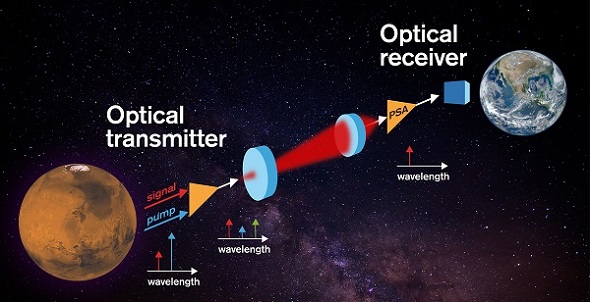A laser-based space communication system developed by researchers at Chalmers University of Technology uses an almost noiseless preamplifier to improve reach and data rates for space communications. The research has implications for technologies such as intersatellite communication, deep-space missions, and Earth monitoring with lidar.
The Chalmers team’s system overcomes losses over large distances in space by significantly increasing the sensitivity of the receiver, while encoding information onto a single wave, which, along with a pump wave at a different frequency, generates a conjugated wave in a nonlinear medium. The waves are launched together into the free space, where they eventually reach the receiver.
After capturing the light in an optical fiber, the phase-sensitive amplifier (PSA) amplifies the signal using a regenerated pump wave. A conventional receiver is then able to detect the amplified signal.
The concept showed a receiver sensitivity of just one photon-per-information bit at a data rate of 10 Gbit/s.

Experimental setup of the free space communications design developed by researchers at Chalmers University. Courtesy of Yen Strandqvist/Chalmers University of Technology.
“Our results show the viability of this new approach for extending the reach and data rate in long-distance space communication links. It therefore also has the promise to help break through the present-day data-return bottleneck in deep-space missions that space agencies around the world are suffering from today,” said Peter Andrekson, head of the research group at the Department of Microtechnology and Nanoscience at Chalmers.
Data-return bottlenecks, Andrekson said, result from very low data rates. NASA, he added, said that to transmit a 1-ft-resolution map of Mars’ surface at 1 bit/pixel would require nine years at 5 Mbit/s.
Over long distances, light beams experience a significant loss in power. A beam sent from Earth to the moon, a distance of about 400,000 km, with a 10-cm aperture, will experience a loss of power of around 80 dB, meaning that only 1 part in 100 million will remain. Because transmittable power is limited, it is important to have receivers that can recover the information sent with as low power (received) as possible. This sensitivity is quantified as the minimum number of photons per information bit necessary to recover the data without error.
Two mutually coherent wavelengths that constructively interfere share the amplifier’s signal in the researchers’ system, sensing more gain than noise as a result. Noise, Andrekson said, does not constructively add.
“The amplification itself relies on a nonlinear process (four wave mixing) in a piece of silica fiber,” Andrekson said. “This results in a possible 0 dB noise figure (the experimental value was about 1 dB) and this is the only known type of amplifier to reach this.”
Conventional amplifiers rely on stimulated emission, which is associated with spontaneous emission and results in significant and unavoidable excess noise.
“This approach fundamentally results in the best possible sensitivity of any preamplified optical receiver and also outperforms all other current state-of-the-art receiver technologies,” Andrekson said.
The system uses a simple modulation format encoded with a standard error correction code and a coherent receiver with digital signal recovery. The method is additionally scalable to much higher data rates if needed. It also operates at room temperature, which allows its implementation in space terminals, as opposed to only on the ground.
The research was published in Light: Science & Applications (www.doi.org/10.1038/s41377-020-00389-2).